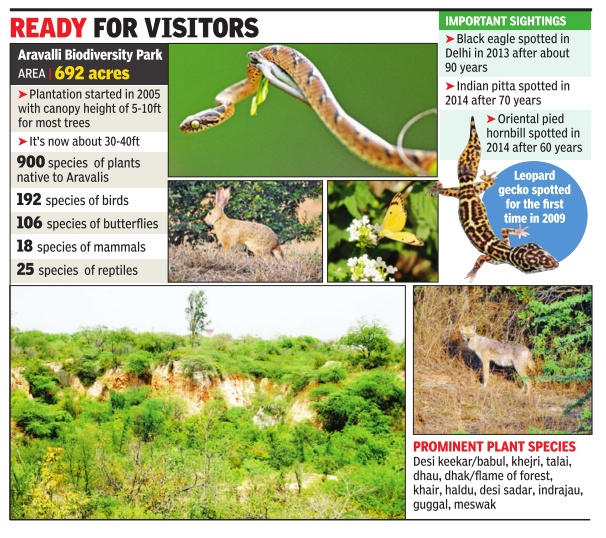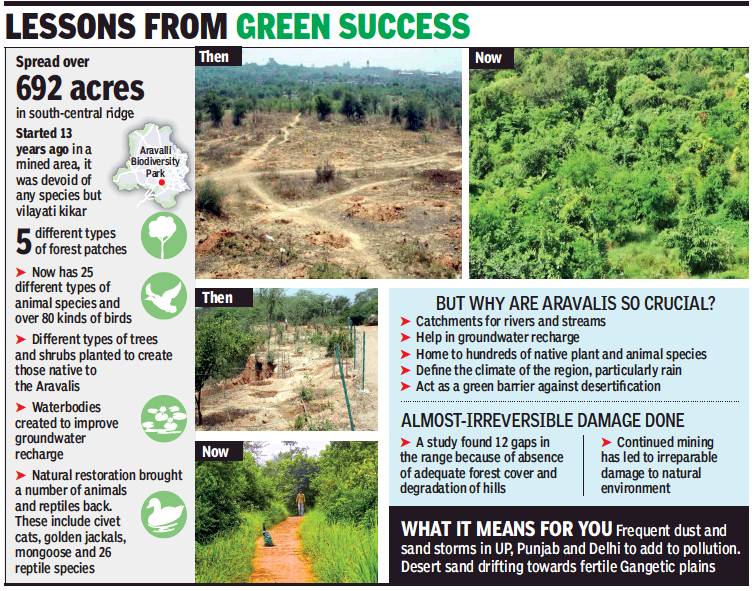Delhi: Aravali park

This is a collection of articles archived for the excellence of their content. |
Contents |
Replacement of foreign with native species
The results, 2005-14
The Times of India, Apr 22 2015
Jayashree Nandi
Planted after removing the Invasive Vilayati Keekar species, it now boasts native flora & fauna
Ten years after the first plantations began in a mining-ravaged stretch of the Aravali range in Delhi, a forest is in bloom. The Aravalli Biodiversity Park in Vasant Vihar, set up on the same site where Delhi Development Authority planned a luxury hotel in 1996, was inaugurated. Had it not been for a PIL in the Supreme Court, this important lung would have been all brick and mortar. The canopy height of trees here has reached 30-40 feet and the mini bio-reserve already boasts of some fascinating wildlife sightings. The leopard gecko and the black eagle have both made an appearance. Developed almost entirely by biologists with a meticulous selection of flora from all over Aravalis stretching from the capital to Gujarat, it is a successful scientific ex periment--to revive land that had nothing but Prosopis julifora or vilayati keekar for a cover.
The Centre for Environmental Management of Degraded Ecosystems under Delhi University that took up the project for DDA got the keekar uprooted first, making a clearing for native species to grow in the form of biotic communities--a group of species that belong to the same region.
Interestingly , the same people who filed a PIL in SC to secure the area have now confronted the park authorities claiming the pristine ecology of a “thorn forest“, typical of a quarry , has been altered by the biodiversity park project.
Vikram Soni, a scientist who works extensively on water-related issues, and a couple of others recently approached C R Babu, professor emeritus and head of CEMDE, who conceptualized biodiversity parks in Delhi. Their complaints are mainly against a fernarium and an orchidarium being developed inside the park.“They cut down a naturally generated dense biodiverse quarry forest to build a fernery , an orchidaium and a butterfly parks,“ Soni said.
But the reality is different. The park has only native Aravali varieties and is using some deep mining pits where moisture levels are higher and it's comparatively cooler to grow orchids and ferns.
Babu says such biodiversity parks are critical for big cities.“When we started, we didn't change the contours of the mining pits. We wanted to use them as water recharge pits so not a single drop is wasted. The native plant species started attracting birds that were not seen for decades.“
“The Ridge or Aravalis are not only about vilayati keekar. They had many other species that never got a chance to grow after keekar invaded these forests. The biodiversity park brings these species back,“ he says. Students are conducting studies; many doing their dissertations on the park. One will soon publish a paper on air quality inside the park in comparison to other parts of the city . “This is like a living museum or a lab. We have to understand that the park has been created. It was not naturally like this, at the same it has revived original Aravali species, including some Jurassic-era ones like mosses and lichens,“ M Shah Hussain, scientist in charge, ABP , says.
While the debate on whether plantations or scientific intervention is required to regenerate such forests infested with invasive species, experts believe this green patch has given much relief to a capital struggling to breathe.
The results, 2005-18

From: Jasjeev Gandhiok, Aravalli Biodiversity Park tells tale of 13-yr course correction, April 15, 2019: The Times of India
The near-irreversible damage done to the Aravalis by human greed in the name of development is well chronicled. However, there is still some hope of saving the hills, as is evident from a visit to the Aravalli Biodiversity Park on the outskirts of the city.
What started as an experiment 13 years ago at a 692-acre plot near Vasant Kunj has seen the area being transformed with 20 different forest communities developed — all by planting native species to produce a three-tier forest. The number of plant species has increased from 150 in 2005 to 902 in 2018.
M Shah Hussain, scientist in-charge at ABP, told TOI that the work began in 2005 with several landscaping surveys carried out to prepare a list of plant and tree species suitable for each area. Hussain said each location displayed mini-habitats, forcing them to choose species accordingly.
“There were 150 plant species in 2005 when we began work in the area. The last survey in 2018 revealed a total of 902 species. Similarly, 31 aquatic plants were added in the last 13 years to revive waterbodies in the area,” Hussain said.
The biodiversity park has 18 different species of mammals as also 26 of reptiles and 113 different kinds of butterflies and moths. Three rare bird sightings were also made recently. “We sighted the Indian pitta here after 70 years, a pied hornbill after 40 years and a black eagle after 90 years, a good indicator that the habitat is conducive to animals and birds,” Hussain said. He added that work on around 400 acres of the biodiversity park was complete so far.
Nature trails are conducted daily at the park now, with sightings of porcupine, civet cats, Indian hare and golden jackals all being a part of it. “The next step is to extend these forest communities and eventually cover the entire 692 acres. People are encouraged to take part in nature trails and discover more about the Aravali range,” Hussain said.
Suhas Borker, founder member of Green Circle of Delhi, an environment group, said focused efforts in the Aravalis could help shape their revival. “The recent directions of the Supreme Court against construction in the Aravalis is a welcome step. While damage may have been done, it is a deterrent to those trying to encroach upon this terrain, which has already been mined considerably,” said Borker, speaking at a conference recently on “How to protect the Aravalis and its importance to Delhi”.
Faiyaz Khudsar, scientist in-charge at the Yamuna Biodiversity Park, said keeping in mind the habitat was crucial for reviving the area, with ABP and other green pockets acting as major centres for carbon sequestration and dust trapping. “The Aravali range is a natural barrier against dust storms and a three-canopy forest level, such as the one developed here, not only traps dust but also actively helps in carbon sequestration. The water holding and recharge capacity of the area, therefore, naturally improves,” Khudsar said.